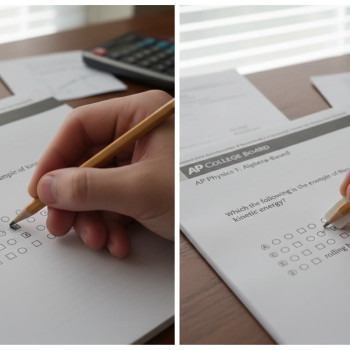Why Random Variables Matter (and Why You’ll Actually Enjoy This)
Random variables are the backbone of probability and statistics. For AP Statistics students, they’re not an abstract idea hiding in the textbook—they’re a language for describing uncertainty, making predictions, and solving problems with logic and simplicity. Learn to think with random variables and you’ll see distributions, means, and standard deviations start to feel like friendly tools instead of scary formulas.

Core Concepts: What Is a Random Variable?
At its heart, a random variable (RV) is a rule that assigns a number to each outcome in a probability experiment. We usually talk about two flavors:
- Discrete random variables: Countable outcomes (e.g., number of heads in three coin flips).
- Continuous random variables: Outcomes on a continuum (e.g., time taken to complete a lab experiment).
AP exam questions often focus on discrete RVs early on, then bring in continuous ideas when dealing with normal or sampling distributions. Either way, two measures are central: expected value (mean) and standard deviation (SD).
Expected Value: The Long-Run Average
The expected value, E(X), is the weighted average of all possible values of an RV, weighted by their probabilities. Think of it as the long-run average if you could repeat the experiment infinitely. It’s not always a value you can actually see in a single trial—but it tells you what to expect on average.
Formula for discrete X: E(X) = Σ x * P(X = x)
Standard Deviation: How Much Variation?
The standard deviation measures spread—how much the values tend to differ from the mean. For a discrete RV, SD is the square root of the variance (Var(X) = E[(X – E(X))^2]). SD tells you whether outcomes cluster around the mean or are widely scattered.
Worked Example: A Simple Game
Imagine a mini-game: roll a fair six-sided die. If you roll a 6, you win $10. Otherwise you win nothing. Define X = your winnings.
- P(X = 10) = 1/6
- P(X = 0) = 5/6
Expected value: E(X) = 10*(1/6) + 0*(5/6) = 10/6 ≈ 1.6667 dollars.
Variance: Var(X) = E(X^2) – [E(X)]^2.
- E(X^2) = 100*(1/6) + 0*(5/6) = 100/6 ≈ 16.6667.
- Var(X) = 16.6667 – (1.6667)^2 ≈ 13.6111.
- SD(X) ≈ sqrt(13.6111) ≈ 3.6896 dollars.
Interpretation: On average you earn about $1.67 per play, but there’s considerable variation because most plays give $0 while occasional plays give $10.
Combining Random Variables: Rules That Make Life Easier
AP questions frequently ask you to combine random variables—add them, subtract them, scale them. Powerful, simple rules let you compute means and SDs without reinventing the wheel.
Means are Linear
If X and Y are random variables, then E(aX + bY + c) = aE(X) + bE(Y) + c. That’s it. Linearity of expectation doesn’t require independence. That makes it one of the most useful tools in problem solving.
Variance and Independence
Variance is not linear in general. But if X and Y are independent, Var(X + Y) = Var(X) + Var(Y). For independent variables, variances add even when the means simply add. If variables are not independent, you must account for covariance: Var(X + Y) = Var(X) + Var(Y) + 2Cov(X,Y).
Scaling
Multiply a random variable by a constant a and its mean multiplies by a, while its variance multiplies by a^2. That gives SD multiplied by |a|. Formally:
- E(aX) = aE(X)
- Var(aX) = a^2 Var(X)
- SD(aX) = |a| SD(X)
Common AP Problems and How to Attack Them
AP-style questions blend computation and interpretation. Below are common patterns and efficient ways to handle them.
Pattern 1: Sum of Independent Identical Trials
Example: Sum of n independent Bernoulli trials (success probability p). If each trial is X_i with mean p and variance p(1 – p), then:
- E(Sum) = np
- Var(Sum) = np(1 – p)
- SD(Sum) = sqrt[np(1 – p)]
This is the bridge to binomial distributions and later sampling distributions.
Pattern 2: Linear Combinations
Given two independent scores X and Y, exam score = 0.6X + 0.4Y. Use linearity for mean and variance rules for SD. Always check independence when adding variances.
Pattern 3: Conditional and Dependent Variables
If X and Y are dependent, you’ll often be given Cov(X,Y) or asked to reason qualitatively about dependence. Translate dependency into covariance when you need exact variance. If not specified, don’t assume independence—read carefully.
Table: Quick Formula Reference
| Quantity | Formula | When to Use |
|---|---|---|
| Expected Value (Discrete) | E(X) = Σ x·P(X=x) | Compute the long-run average |
| Variance | Var(X) = E(X^2) – [E(X)]^2 | Measure of spread; square of SD |
| SD | SD(X) = sqrt(Var(X)) | Spread in original units |
| Linearity of Expectation | E(aX + bY + c) = aE(X) + bE(Y) + c | Always valid |
| Variance of Sum (Independent) | Var(X + Y) = Var(X) + Var(Y) | Use when X and Y independent |
| Scaling | Var(aX) = a^2 Var(X) | Multiplying by constants |
Practice Problem: Combine It All
Scenario: A student earns points from two independent activities: a quiz (Q) and a project (P). Q ~ mean 12, SD 3. P ~ mean 28, SD 5. Final score S = 0.4Q + 0.6P.
- E(S) = 0.4*12 + 0.6*28 = 4.8 + 16.8 = 21.6
- Var(S) = (0.4^2)*(3^2) + (0.6^2)*(5^2) because Q and P are independent.
- Var(S) = 0.16*9 + 0.36*25 = 1.44 + 9 = 10.44
- SD(S) = sqrt(10.44) ≈ 3.232
Interpretation: The weighted average puts more emphasis on the project (P). The SD tells you typical deviation from the expected 21.6 points is about 3.23 points.
Tips for AP-Style Multiple Choice and FRQ Questions
AP graders look for correct reasoning and clarity. In multiple choice, speed and care matter. In free-response questions (FRQs), show steps succinctly and label your results.
Strategy Checklist
- Write down what X represents—clear notation prevents mistakes.
- State whether variables are independent before adding variances.
- Use linearity of expectation whenever possible—it’s a fast path to the mean.
- When scaling variables, remember variance scales by the square of the constant.
- In FRQs, box your final numerical answer and give units if appropriate.
Common Misconceptions and How to Avoid Them
Students often mix up mean and median, confuse variance with standard deviation units, or forget independence when adding variances. Here’s how to avoid those pitfalls.
Misconception: Means Add, So Variances Add Too
Only add variances when variables are independent (or you account for covariance). Always ask: “Are these variables independent?” If not given, don’t assume it.
Misconception: SD Has Same Algebraic Rules as Mean
SD doesn’t obey linearity like the mean. If you shift a random variable by a constant (X + c), the SD stays the same. If you multiply by a constant, SD is multiplied by the absolute value of that constant.
Misconception: Expected Value Must Be a Possible Outcome
Not true. Expected value can be a number that never appears as an individual outcome (e.g., expected number of heads in one coin toss is 0.5).
Study Routine That Actually Works (and Fits a Busy Life)
Preparing well for AP Statistics is less about cramming formulas and more about pattern recognition and practice. Here’s a study plan you can adapt to your schedule.
Weekly Plan (6 Weeks Before Exam)
- Week 1: Review definitions—random variable types, expectation, variance, SD. Do 10 targeted MCQs.
- Week 2: Practice linear combinations and scaling problems. Do 2 FRQs and time them.
- Week 3: Dive into binomial and sampling distributions; practice means and SDs for sums.
- Week 4: Work on interpreting results—explain what the mean and SD mean in context at least 5 times.
- Week 5: Mixed practice—50% MCQs, 50% FRQs. Review common mistakes and rework errors.
- Week 6: Simulated timed exam and targeted review of weak spots.
Short, consistent practice beats marathon sessions. Use practice problems to force you to state assumptions (independence, population vs. sample, etc.) and to explain context in words—not just numbers.
How Personalized Tutoring (Like Sparkl’s) Helps
When concepts start to blur—especially combinations, covariance, and the nuance of independence—a personalized approach can accelerate learning. Sparkl’s personalized tutoring offers 1-on-1 guidance, tailored study plans, expert tutors, and AI-driven insights that target your weak spots. Imagine an expert tutor reviewing your FRQ approach, pointing out where you assumed independence incorrectly, and giving a few alternate scenarios to practice—that kind of targeted feedback is what moves students from confusion to clarity.
Practice Sets: Build Intuition with Variation
Adapt these short prompts into practice problems. Work them out, then explain your answers in one or two sentences—explanation is the key to retention.
- Flip a fair coin four times. Let X = number of heads. Compute E(X) and SD(X).
- Two independent dice are rolled. Let A = first die, B = second die. Find E(A + B) and SD(A + B).
- Define Y = 5X – 2 where X ~ mean 3, SD 1.5. Find E(Y) and SD(Y).
- Quiz and project example revisited: change weights and check how mean and SD respond.
Real-World Context: Beyond the Classroom
Random variables are everywhere. Actuarial tables, polling margins of error, quality control in manufacturing, and A/B testing in product design all depend on means and variability. Understanding the effect of combining measures—like combining results from two different polls—helps interpret real-world headlines instead of being misled by isolated numbers.
Example: Polling
Two separate polls produce independent estimates of the same proportion. Averaging them reduces variance (it’s like combining independent measurements), which explains why aggregated polling often produces more stable estimates than a single poll.
AP Exam Day Checklist for Random Variable Questions
- Read the entire problem first—identify what the random variables are and whether they are independent.
- Label variables and write E(X) and SD(X) where possible before manipulating expressions.
- Use linearity of expectation early—it often shortens computations.
- If you must assume independence, state it explicitly (unless the problem states it).
- Box your final numerical answers and include units or interpretive sentences for FRQs.
Two-Minute Diagnosis: Quick Ways to Check Your Work
After solving a problem, spend two minutes doing a reality check:
- Does the mean lie within the range of possible values (if it should)?
- Is SD non-negative and sensible relative to the possible spread?
- If you scaled the variable, did the SD scale by the absolute value of the factor and variance by its square?

Final Thoughts: From Rules to Intuition
Formulas are tools, but interpretation is where real mastery lives. When you practice, don’t just compute—ask what the numbers mean. What does E(X) tell you about typical outcomes? What does the SD suggest about the reliability of that expectation? When you can answer those questions clearly, you’ll not only perform better on the AP exam—you’ll start to think like a statistician.
And when you want focused help—targeted practice problems, feedback on FRQs, or a personalized plan to shore up weak spots—1-on-1 tutoring can be the difference between being “pretty good” and truly confident. Sparkl’s personalized tutoring combines expert tutors and AI-driven insights to give that kind of precision coaching exactly when you need it.
Quick Reference: Cheat Sheet You Can Memorize
- E(aX + bY + c) = aE(X) + bE(Y) + c
- Var(X + Y) = Var(X) + Var(Y) if X and Y independent
- Var(aX) = a^2 Var(X); SD(aX) = |a| SD(X)
- E(X) is the long-run average, SD is spread in original units
Closing Note
Mastering random variables is a lot like learning a musical instrument: small, consistent practice, thoughtful feedback, and the occasional guided lesson accelerate progress enormously. Use practice problems to build pattern recognition, explain your reasoning out loud (or in writing), and when you need it, seek personalized help to target exactly where you stall. You’ve got this—random variables are not obstacles; they’re powerful ways to understand the world when you give them a chance.
Keep Practicing
Do one combination-style problem today. Explain the result in a sentence. Tomorrow, do another with a twist. In a few weeks you’ll be surprised how automatic these computations feel—and that’s the moment when you’ll stop fearing the AP Statistics exam and start owning it.





















No Comments
Leave a comment Cancel